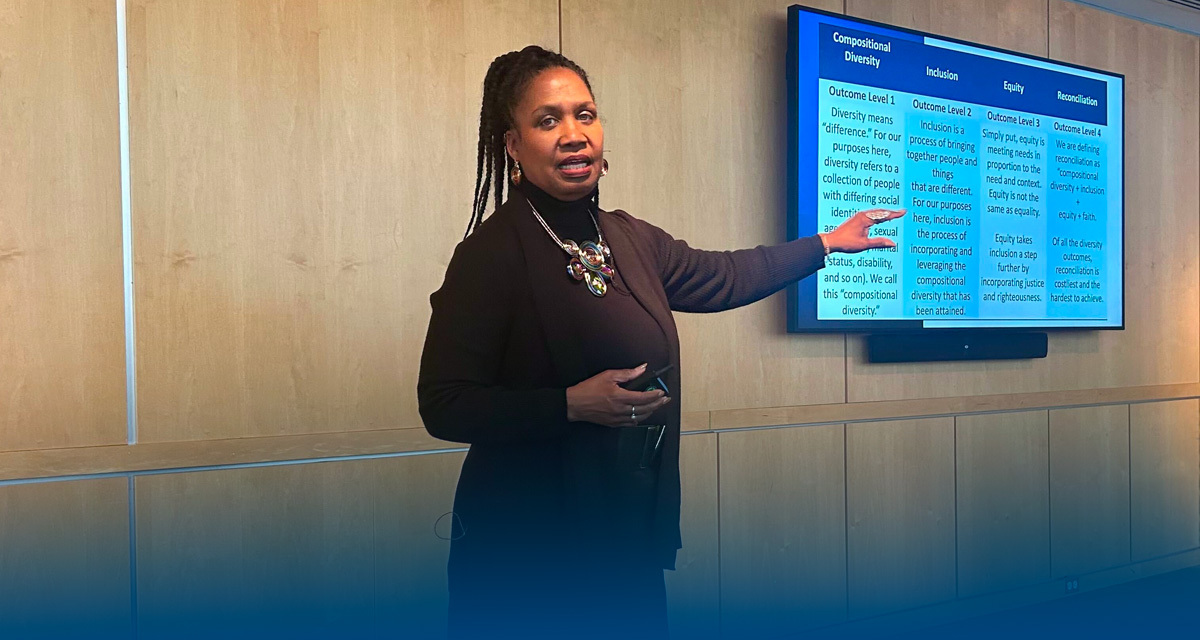Driving Diversity: Dr. Michelle Loyd-Paige on Challenges, Strategies and Solutions
As organizations work to embrace and welcome diversity, the process isn’t without challenges. The struggle is real, says Dr. Michelle Loyd-Paige, author of The Diversity Playbook and a 30-year veteran in the diversity education field. But that doesn’t mean it’s impossible.
At a Center for Faith and Inquiry (CFI) event on Tuesday, March 26, Loyd-Paige talked about the different levels of diversity, the struggles against it and how to practically take action to establish it. To make our campuses, workplaces, churches and other communities safe and diverse spaces, she said, we need to know what we’re up against so we can have conversations and create action that truly leads to flourishing for everyone in our spaces.
The Four Types of Diversities
Many organizations would say they want to improve diversity and be known as a welcoming and inclusive place, maybe even a reconciling place, but they don’t always know what that means—or even what they truly want to accomplish, says Loyd-Paige. Understanding the four types of diversity can help:
- Compositional diversity: a group of people with differing social identities—race, age, gender, marital status, disability, etc.—that already exists without diversity efforts. “You can bring people in, but the question is, do you just want the faces, or do you want all of who they represent? There are a lot of multiracial churches and some multiracial schools but not a lot of multicultural institutions,” Loyd-Paige says.
- Inclusion: bringing together different people and leveraging compositional diversity to ensure all feel welcomed or listened to. “If you’re going to do the hard work to bring people in, and if you’re not going to leverage the diversity that’s there, don’t bother bringing people in,” says Loyd-Paige. “Don’t say you want my voice and then never ask me anything.”
- Equity: not the same as equality, where everyone gets the exact same treatment. This takes inclusion a step further with personalized, tangible action. “Inclusion could mean, ‘I hear what you’re saying, and I really value what you’re saying,’ but everything stays the same. When things are going to change, when there is some parity that’s developing, that’s when we’re getting to the level of equity.”
- Reconciliation: a combination of compositional diversity, inclusion and equity that also incorporates faith. “As Christians our language is not just about being a multicultural church or multigenerational church. Our greater emphasis is about being a reconciled community. We want to change things so that everyone has a sense of belonging, everyone cares for one another’s situation. We don’t just speak up about things because it’s happening to me; we speak up about things because they’re happening to our brothers and sisters in Christ with us.”
Struggles Against Diversity
If the goals of equity and reconciliation are so good to have, why does it seem like many diversity initiatives fail? Loyd-Paige identifies several causes:
- Heightened awareness and urgency in our society over long-term change
- Increased resistance in our individualistic society to conversations about diversity
- Severe mental and emotional challenges for our personal well-being
- Lack of institutional critique and accountability
These challenges can manifest in different ways. For example, an organization may drive diversity efforts but lack support from senior leadership, limiting the ability of those efforts to permeate the entire organization. Maybe there’s a lack of financial, human, technical or symbolic resources. Perhaps the resources aren’t properly used, and the outcomes aren’t properly assessed to see if there’s real change. These are all obstacles that need to be considered or removed for diversity to flourish.
“I’ve been told, ‘If you would stop talking about racism, there wouldn’t be a problem,’” Loyd-Paige states. “If me not talking about racism would solve racism, I would have my mouth wired shut just to make sure I wouldn’t accidentally say something about it. But can you imagine if we said the same thing about another social issue?”
How to Encourage Diversity
Practically speaking, to overcome these challenges and incorporate diversity, any organization needs three things, according to Loyd-Paige: a shared commitment, sustained momentum over time and a culture willing to SHIFT:
- See the problems, especially through the eyes of others
- Heighten and bring those problems to attention
- Identify what you can start on, knowing you can’t do everything at once
- Facilitate with others to help you enact change
- Transform your organization
“Start where you are, and then do something. Don’t end up being paralyzed because there’s so much to choose from, and so you decide not to do anything. Pick something. Get it a dart, throw it on board. You can do that.”
Dr. Michelle Loyd-Paige
 The Bell
The Bell